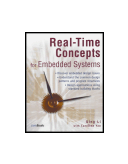Книга: Real-Time Concepts for Embedded Systems
16.3.5 Deadlock Prevention
16.3.5 Deadlock Prevention
Deadlock prevention is a set of constraints and requirements constructed into a system so that resource requests that might lead to deadlocks are not made. Deadlock prevention differs from deadlock avoidance in that no run-time validation of resource allocation requests occurs. Deadlock prevention focuses on structuring a system to ensure that one or more of the four conditions for deadlock i.e., mutual exclusion, no preemption, hold-and-wait, and circular wait is not satisfied.
This set of constraints and requirements placed on resource allocation requests is as follows:
· Eliminating the hold-and-wait deadlock condition. A task requests at one time all resources that it will need. The task can begin execution only when every resource from the request set is granted.
This requirement addresses the hold-and-wait condition for deadlock. A task that obtains all required resources before execution avoids the need to wait for anything during execution. This approach, however, has limited practicality and several drawbacks. In a dynamic system, tasks have difficulty predicting in advance what resources will be required. Even if all possible resource requirements could be accurately predicted, this prediction does not guarantee that every resource in this predicted set would be used. Execution paths, which external factors affect, determine which resources are used.
One major drawbacks to this approach is the implicit requirement that all resources must be freed at the same time. This requirement is important because a resource can be needed in multiple code paths; it can be used and later be reused. So, the resource must be kept until the end of task execution. Some of the resources, however, might be used once or used only briefly. It is inefficient for these resources to be kept for a long time because they cannot be reassigned to other tasks.
· Eliminating the no-preemption deadlock condition. A task must release already acquired resources if a new request is denied. The task must then initiate a new request including both the new resource and all previously held resources.
This requirement addresses the no-preemption condition for deadlock. This approach is slightly more dynamic than the previous method in that resources are acquired on an as-needed basis and only those resources needed for a particular execution path, instead of all possible resources, are acquired.
This approach, however, is not much better than the previous one. For tasks holding non-preemptible resources, this requirement means that each task must restart execution either from the beginning or from well-defined checkpoints. This process nullifies partially complete work. Potentially, a task might never complete, depending on the average number of tasks existing in the system at a given time and depending on the overall system scheduling behavior.
· Eliminating the circular-wait deadlock condition. An ordering on the resources must be imposed so that if a task currently holds resource Ri, a subsequent request must be for resource Rj where j › i. The next request must be for resource Rk where k › j, and so on.
This imposition addresses the circular-wait condition for deadlock. Resources are organized into a hierarchical structure. A task is allowed to acquire additional resources while holding other resources, but these new resources must be higher in the hierarchy than any currently held resources.




